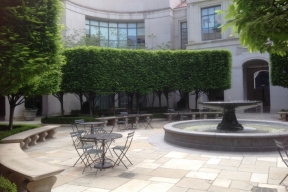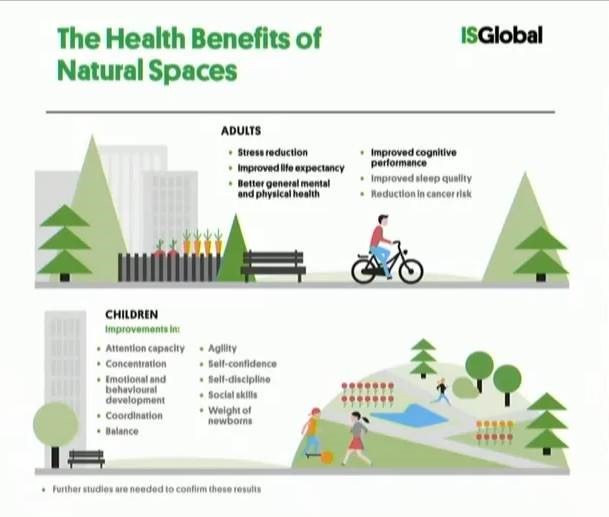Green & Open Spaces
Green and open spaces are places that are intentionally not developed. These places are important for resting, recharging and free play. Green spaces provide both physical and mental health benefits when people reconnect with Nature.

Why plan for green and open spaces?
How do green and open spaces encourage physical activity?
What makes a good green or open space?
What are the benefits of plants and wildlife?
What are some ways to conserve land?
What about reusing eyesore properties?
What about community gardens?
Government partners
Helpful documents
Why plan for green and open spaces?
Green and open spaces come in many familiar forms like parks, playgrounds, nature trails, community gardens, natural areas and city plazas. Grassy fields, tree-lined streets, picnic tables, greenways and rooftop terraces all can be a restful place during a busy day. Green and open spaces help people relax from stress and reconnect with nature. Green and open spaces can reduce heat islands and air pollution in urban environments. These spaces are important for collecting and naturally filtering stormwater running off of impervious pavement. Green and open spaces can improve human health by making cities and towns more beautiful, safer and healthier places to live, work, visit and play.
Here are some links with more informatino about the ways green spaces can improve health:
- Health Benefits of Urban Natural Spaces
- Living Close to Green Space May Improve Cognitive Function in Adults
- Living Close to Green Spaces is Associated with Better Attention in Children

Green and open spaces allow people to relax and roam. Relaxing helps to reduce stress and improve mental health. Roaming, whether on paved sidewalks, natural trails or through a grassy field, increases physical activity. Green and open spaces can be designed with opportunities for free play or structured exercise. Many green and open spaces offer numerous opportunities for active recreation like hiking trails, ballfields, bike paths, scenic overlooks or greenways. Find more ideas on our Healthy Places Parks webpage.
What makes a good green or open space?
There are numerous successful green and open spaces across Tennessee. All spaces need to be safe for children and older adults. When a space can be connected with the local culture or a historical event, it creates an even more unique place to be. The public square in rural Troy, Obion County, is a great example of a shared used space. In downtown Nashville, Davidson County, the courthouse has a multipurpose green area. The green area covers an underground parking garage, collects rainwater for irrigating landscaping, provides places for workers to relax, is an event space and hosts pick-up sports. In downtown Maryville, Blount County, sidewalks and two ends of greenway connect a peaceful green space and performance stage. If possible, green and open spaces should offer at least a little shade from the hot sun, a place to sit and rest, and drinking water for people and pets.
What are the benefits of plants and wildlife?
People, young and old, enjoy interacting with wildlife. Green and open spaces are good for the environment. These places often preserve plant and wildlife habitat. Even small green spaces can be great places for bird watching, fishing or feeding animals. Plants, especially trees, are important for absorbing stormwater, providing shade and reducing greenhouse gases. Protecting forests can increase recreational opportunities like hiking and camping. Naturally beautiful plants and wildlife add vibrancy to communities, which is good for economic stability and public health.
What are some ways to conserve land?
If there is no planning or all open zoning, potential green and open spaces might be lost to development. Too much development without a green pause here and there can be adverse to both future development and community health. Designating areas to remain green whether as parks, forests, natural areas or open spaces makes a promise that it will always be there for people to benefit from. Conservation also supports jobs in industries like agriculture, forestry, tourism and recreation. A city or county taking ownership of a green space is a common way to conserve it. Sometimes private ownership recognizes the value of a naturally beautiful place and endeavors to preserve it. Land trusts, land retirement programs, conservation easements and private reserves are some of the land conservation programs available to landowners and communities. These programs have successfully protected millions of acres of land while keeping it in private hands and generating significant public benefits. Groups like the Land Trust for Tennessee and The Nature Conservancy have protected some two million acres in the United States. Some protected places are open to public to enjoy.
What about reusing eyesore properties?
Some places may be run down, blighted or environmentally contaminated. These “Brownfield” sites may be able to be reclaimed and reused as green or open spaces. Brownfield sites in inner cities have been reclaimed as small parks. Larger sites have been successfully reused as parks, ballfields or amphitheaters after cleanup. Green or open spaces often increase property value when incorporated into development, especially when those spaces preserve the community’s history. Visit our Healthy Places Brownfields webpage for more ideas about reusing old sites.
What about community gardens?
Community gardens increase green space. Community agriculture and gardening is becoming more popular as it increases access to healthy, nutritious and low-cost produce. Gardeners even increase their physical activity turning soil, watering, weeding and harvesting their gardens. Community gardens grow pride and nurture social cohesion. Gardening on underused or abandoned properties improves the visual esthetics of a neighborhood and can even increase real estate values. EPA’s Growing Gardens in Urban Soils factsheet helps communities and individuals safely reuse potentially contaminated landscapes. The University of Tennessee Extension is one of the best resources for community gardening.
Government Partners
Tennessee Department of Environment and Conservation (TDEC)
Recreation Eduacation Services
www.tn.gov/environment/program-areas/res-recreation-educational-services.html
U.S. Environmental Protection Agency (EPA)
www.epa.gov
Helpful documents
U.S. Environmental Protection Agency (EPA)
From Brownfields to Green: In Praise of Open Spaces
www.epa.gov/sites/production/files/2015-10/documents/epa_oblr_successstory_region9_openspace_v2_508.pdf (PDF)
World Health Organization (WHO)
Urban Green Spaces and Health
www.euro.who.int/__data/assets/pdf_file/0005/321971/Urban-green-spaces-and-health-review-evidence.pdf (PDF)